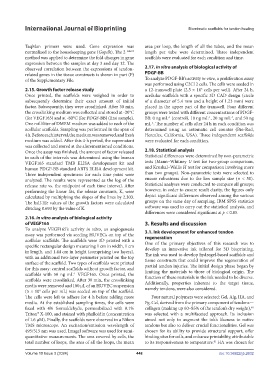Page 456 - IJB-10-3
P. 456
International Journal of Bioprinting Biomimetic scaffolds for tendon healing
TaqMan primers were used. Gene expression was area per loop, the length of all the tubes, and the mean
normalized to the housekeeping gene (Gapdh). The 2 −ΔΔCT length per tube were determined. Three independent
method was applied to determine the fold changes in gene scaffolds were evaluated for each condition and time.
expression between the samples at day 3 and day 12. The
observed correlation between the expressions of tendon- 2.17. In vitro analysis of biological activity of
related genes in the tissue constructs is shown in part (F) PDGF-BB
of the Supplementary File. To analyze PDGF-BB’s activity in vitro, a proliferation assay
was performed using C2C12 cells. The cells were seeded in
2.15. Growth factor release study a 12-transwell plate (2.5 × 10 cells per well). After 24 h,
5
Once printed, the scaffolds were weighed in order to acellular scaffolds with a specific 3D CAD design (circle
subsequently determine their exact amount of initial of a diameter of 5.4 mm and a height of 1.23 mm) were
factor. Subsequently, they were crosslinked. After 30 min, placed in the upper part of the transwell. Four different
the crosslinking medium was collected and stored at -20°C groups were tested with different concentrations of PDGF-
(for VEGF165) and at -80°C (for PDGF-BB) (first sample). BB: 0 ng mL (control), 10 ng mL , 20 ng mL , and 50 ng
-1
-1
-1
One milliliter of DMEM medium was added to each of the mL . The number of cells after 24 h in each condition was
-1
acellular scaffolds. Sampling was performed in the span of determined using an automatic cell counter (Bio-Rad,
4 h. Before each interval, the medium was removed, and fresh Hercules, California, USA). Three independent scaffolds
medium was added. After this 4-h period, the supernatant were evaluated for each condition.
was collected and stored at the aforementioned conditions.
Once the assay was finished, the amount of factor released 2.18. Statistical analysis
in each of the intervals was determined using the human Statistical differences were determined by non-parametric
VEGF165 standard TMB ELISA development kit and tests (Mann–Whitney U test for two-group comparison,
human PDGF-BB standard ABTS ELISA development kit. and Kruskal–Wallis H test for comparison involving more
Three independent specimens for each time point were than two groups). Non-parametric tests were selected to
analyzed. The results were represented as the log of the ensure robustness due to the low sample size (n < 50).
release rate vs. the midpoint of each time interval. After Statistical analyses were conducted to compare all groups;
performing the linear fits, the release constants, K, were however, in order to ensure result clarity, the figures only
calculated by multiplying the slopes of the lines by 2.303. depict significant differences observed among the various
The half-life values of the growth factors were calculated groups on the same day of sampling. IBM SPSS statistics
dividing 0.693 by the value of K. software was used to carry out the statistical analysis, and
differences were considered significant at p < 0.05.
2.16. In vitro analysis of biological activity
of VEGF165 3. Results and discussion
To analyze VEGF165’s activity in vitro, an angiogenesis 3.1. Ink development for enhanced tendon
assay was performed via seeding HUVECs on top of the regeneration
acellular scaffolds. The scaffolds were 3D printed with a One of the primary objectives of this research was to
specific rectangular design measuring 1 cm in width, 1 cm develop an innovative ink tailored for 3D bioprinting.
in length, and 1.44 cm in height (comprising two layers), The ink was used to develop hydrogel-based scaffolds and
with an additional two-layer perimeter printed on the top tissue constructs that could improve the regeneration of
surface of the scaffold. Two types of scaffolds were printed
for this assay: control scaffolds without growth factor, and partial tendon injuries. The initial design phase began by
scaffolds with 50 ng mL VEGF165. Once printed, the limiting the materials to those of biological origin. The
-1
scaffolds were crosslinked. After 30 min, the crosslinking function of these materials in the ink needed to be diverse.
media were removed and 100 μL of an HUVEC suspension Additionally, properties inherent to the target tissue,
(5 × 10 cells per mL) was seeded on top of the scaffold. namely tendons, were also considered.
6
The cells were left to adhere for 4 h before adding more Four natural polymers were selected: Gel, Alg, HA, and
media. At the established sampling times, the cells were Fg. Gel, derived from the primary component of tendons—
fixed with 4% formaldehyde, permeabilized with 0.1% collagen (making up 60–85% of the tendon’s dry weight),
40
Triton™ X-100, and stained with phalloidin (concentration was selected with a multifaceted approach. Its inclusion
of 1.6 μM). Finally, the scaffolds were observed in a Nikon aimed not only to augment the ink’s likeness to native
TMS microscope. An excitation/emission wavelength of tendons but also to deliver crucial functionalities. Gel was
495/515 nm was used. ImageJ software was used for semi- chosen for its ability to provide structural support, offer
quantitative measurements. The area covered by cells, the binding sites for cells, and enhance printability, attributable
total number of loops, the area of all the loops, the mean to its responsiveness to temperature. HA was chosen for
41
Volume 10 Issue 3 (2024) 448 doi: 10.36922/ijb.2632

